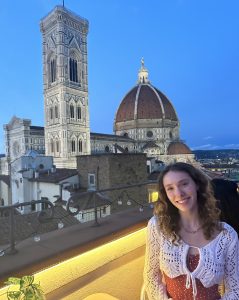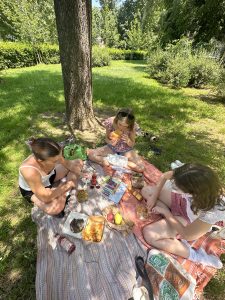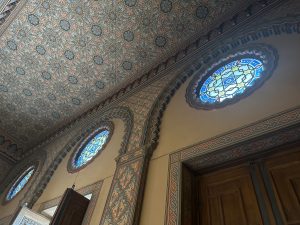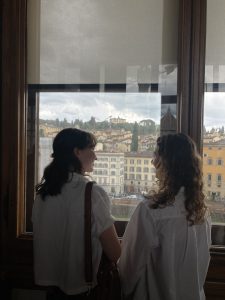Written by: Astrid Ariana | Summer 2023
Arts and Cultural Management in Italy
Growing up Jewish gave me a strong  sense of familial community throughout my entire life. However, I think the United States struggles as a whole to have a strong sense of community. This was strikingly apparent to me while traveling abroad in Italy. Prior to studying abroad in Florence I did extensive research on the Holocaust in Italy as well as the Synagogue and Jewish Museum of Florence. Although their Jewish community has always been small, even greatly diminished, it has remained viable and vibrant.
sense of familial community throughout my entire life. However, I think the United States struggles as a whole to have a strong sense of community. This was strikingly apparent to me while traveling abroad in Italy. Prior to studying abroad in Florence I did extensive research on the Holocaust in Italy as well as the Synagogue and Jewish Museum of Florence. Although their Jewish community has always been small, even greatly diminished, it has remained viable and vibrant.
Most Jews who originally settled in Florence were merchants and money lenders with their community officially founded in 1437. Fortunately, their community was protected by the Medici family, one of the most historically powerful families in Florence, who had major influence in the art and architecture that is iconic to Florence. Without their support, the Roman Catholic clergy would likely have exiled the Jews. When the Medicis briefly fell from power in the 1490s, Jews were ordered to leave the city.
In an effort to preserve their community, they loaned money to the Republic of Florence to delay their expulsion. The tactic worked, and when the Medicis returned to power in1512, the Jewish community grew. Sadly, when Cosimo de Medici consolidated his power, he also enacted a multitude of anti-Jewish laws. He created a special dress code for them and established the Jewish ghetto of Florence in 1571. This was located in the Piazza della Repubblica, a central piazza of Florence that our study abroad group went to frequently. These and other challenges catalyzed tension and disunity, complicated because the Italian Jews were commingled with Spanish and Portuguese Jews.
Napoleonic forces occupied Florence in 1799 leading to a moment of emancipation for the Jews. There was a new constitution created where Jews were given rights. By 1861 Jews were given full citizenship and the ghetto was leveled for urban renewal. But with the Holocaust, World War 2, and the Nazi invasion of Italy, life for Jews deteriorated. Nazis arrested and sent Jews to Auschwitz. Almost all of them were killed except for the few who were hidden and saved by other Italians. Their previous place of worship, The Great Synagogue of Florence was occupied by Nazi soldiers and used for storage. After the war, the Jews who remained, restored their Temple and added a Jewish museum with Jewish ceremonial art. They intended to use the space to help rebuild their community.
The architecture of the Synagogue stands out with Moorish design as well as a bright, teal oxidized roof to stand out on the Florence skyline. The level of preservation of the Synagogue as well as the artifacts and art brought to the Synagogue and museum are incredible. When I visited the Synagogue it cultivated a lot of emotion for me as well as my friends who came. The Synagogue was almost completely empty. Due to excessive tourism in Florence, most churches and historical sites we went to were packed. The fact that there was practically no one there actualized how small the Jewish community in Florence is and the hardships they have faced. It was a much more intimate setting compared to the business of everywhere else we had been, allowing a safe space for us to feel and appreciate the perseverance and determination of these Italian Jews.
I asked the staff member there how all of the artifacts in the museum were so well preserved in spite of the Nazi invasion and occupation of Florence. She responded that everything that remained had simply been hidden very well. For example, one of the Torahs preserved still had completely visible and intact Hebrew. They had also preserved traditional outfits for adults and infants and many other artifacts.
Today, they have built up the community surrounding the Synagogue with Jewish-owned businesses. There are bakeries, restaurants, and many of the Jews live in the area surrounding the Synagogue. It is beautiful to see the community they have fought for and preserved in Italy.
These values of community are apparent to me in every part of Italy that I went to. When we visited Siena, we were fortunate enough to come on a day with a festa titolare. This is a “parade of the districts” where the town puts up their Siena flags and drums throughout all the neighborhoods. Men and boys of all ages marched with drums through the streets dressed in their traditional attire. Their pants were bright red on one side and white with a green stripe on the other side. They had green velvet tops on, some striped with white as well. On their heads they wore a red velvet cap or other red headpiece. We gracefully stumbled upon a community gathered and watched the festa titolare parade through. Everyone seemed to know each other and hugged and celebrated. I was in awe of the feeling of closeness juxtaposed against what seemed to me a very large city.
 My group of close friends, with whom I roomed during my time in Florence, collectively realized these differences of cultural values and knew we wanted to incorporate them into our lives back in the United States. Endeavoring to start immediately, one sunny afternoon in Florence, we went to a local market near our apartment and got an assortment of fresh fruits and vegetables, dried fruits, and lunch items. We brought our things to a park and picnicked together for a long while talking, eating, laughing, and painting in watercolor. That afternoon was so special to us because while we were in Italy, the values we were appreciating were things that we could immediately incorporate into our lives and to inspire us to do so back in the U.S. later. We agreed that when coming back to Butler we would meet every Wednesday evening to cook together and enjoy each other’s presence.
My group of close friends, with whom I roomed during my time in Florence, collectively realized these differences of cultural values and knew we wanted to incorporate them into our lives back in the United States. Endeavoring to start immediately, one sunny afternoon in Florence, we went to a local market near our apartment and got an assortment of fresh fruits and vegetables, dried fruits, and lunch items. We brought our things to a park and picnicked together for a long while talking, eating, laughing, and painting in watercolor. That afternoon was so special to us because while we were in Italy, the values we were appreciating were things that we could immediately incorporate into our lives and to inspire us to do so back in the U.S. later. We agreed that when coming back to Butler we would meet every Wednesday evening to cook together and enjoy each other’s presence.
Americans have become so privatized and separated from one another that it seems loneliness has become normalized. Through studying the Jewish community in Florence, as well as learning about Italian values as a whole, I felt my own values in life shifting. I wanted the closeness of my own Jewish family to inspire me further by creating community in other dimensions of my life. I believe community heals the soul, and I could not be more grateful for the ways Italy changed me, indefinitely, and for the better.


